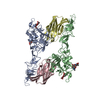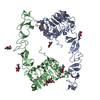Entry Database : PDB / ID : 8ukxTitle Crystal structure the extracellular region of the epidermal growth factor receptor variant III (EGFRvIII) at pH 7.0 Epidermal growth factor receptor Keywords / / / / / Function / homology Function Domain/homology Component
/ / / / / / / / / / / / / / / / / / / / / / / / / / / / / / / / / / / / / / / / / / / / / / / / / / / / / / / / / / / / / / / / / / / / / / / / / / / / / / / / / / / / / / / / / / / / / / / / / / / / / / / / / / / / / / / / / / / / / / / / / / / / / / / / / / / / / / / / / / / / / Biological species Homo sapiens (human)Method / / / Resolution : 3.301 Å Authors Stayrook, S.E. / Ferguson, K.M. Funding support Organization Grant number Country National Institutes of Health/National Cancer Institute (NIH/NCI) R01CA198164 National Institutes of Health/National Cancer Institute (NIH/NCI) R01CA112552
Journal : Structure / Year : 2024Title : Structural insights into the role and targeting of EGFRvIII.Authors : Bagchi, A. / Stayrook, S.E. / Xenaki, K.T. / Starbird, C.A. / Doulkeridou, S. / El Khoulati, R. / Roovers, R.C. / Schmitz, K.R. / van Bergen En Henegouwen, P.M.P. / Ferguson, K.M. History Deposition Oct 15, 2023 Deposition site / Processing site Revision 1.0 Jun 12, 2024 Provider / Type Revision 1.1 Jul 3, 2024 Group / Category / citation_authorItem _citation.pdbx_database_id_DOI / _citation.pdbx_database_id_PubMed ... _citation.pdbx_database_id_DOI / _citation.pdbx_database_id_PubMed / _citation.title / _citation_author.identifier_ORCID / _citation_author.name Revision 1.2 Sep 18, 2024 Group / Category Item / _citation.page_first / _citation.page_lastRevision 1.3 Sep 25, 2024 Group / Category / Item Revision 1.4 Oct 9, 2024 Group / Category / pdbx_modification_feature / Item
Show all Show less
 Yorodumi
Yorodumi Open data
Open data Basic information
Basic information Components
Components Keywords
Keywords Function and homology information
Function and homology information Homo sapiens (human)
Homo sapiens (human) X-RAY DIFFRACTION /
X-RAY DIFFRACTION /  SYNCHROTRON /
SYNCHROTRON /  MOLECULAR REPLACEMENT / Resolution: 3.301 Å
MOLECULAR REPLACEMENT / Resolution: 3.301 Å  Authors
Authors United States, 2items
United States, 2items  Citation
Citation Journal: Structure / Year: 2024
Journal: Structure / Year: 2024 Structure visualization
Structure visualization Molmil
Molmil Jmol/JSmol
Jmol/JSmol Downloads & links
Downloads & links Download
Download 8ukx.cif.gz
8ukx.cif.gz PDBx/mmCIF format
PDBx/mmCIF format pdb8ukx.ent.gz
pdb8ukx.ent.gz PDB format
PDB format 8ukx.json.gz
8ukx.json.gz PDBx/mmJSON format
PDBx/mmJSON format Other downloads
Other downloads 8ukx_validation.pdf.gz
8ukx_validation.pdf.gz wwPDB validaton report
wwPDB validaton report 8ukx_full_validation.pdf.gz
8ukx_full_validation.pdf.gz 8ukx_validation.xml.gz
8ukx_validation.xml.gz 8ukx_validation.cif.gz
8ukx_validation.cif.gz https://data.pdbj.org/pub/pdb/validation_reports/uk/8ukx
https://data.pdbj.org/pub/pdb/validation_reports/uk/8ukx ftp://data.pdbj.org/pub/pdb/validation_reports/uk/8ukx
ftp://data.pdbj.org/pub/pdb/validation_reports/uk/8ukx

 F&H Search
F&H Search Links
Links Assembly
Assembly
 Components
Components Homo sapiens (human) / Gene: EGFR, ERBB, ERBB1, HER1 / Variant: VAR_066493 / Plasmid: PFASTBAC / Cell line (production host): Sf9 / Production host:
Homo sapiens (human) / Gene: EGFR, ERBB, ERBB1, HER1 / Variant: VAR_066493 / Plasmid: PFASTBAC / Cell line (production host): Sf9 / Production host: 
 X-RAY DIFFRACTION / Number of used crystals: 1
X-RAY DIFFRACTION / Number of used crystals: 1  Sample preparation
Sample preparation SYNCHROTRON / Site:
SYNCHROTRON / Site:  APS
APS  / Beamline: 23-ID-B / Wavelength: 1.0722 Å
/ Beamline: 23-ID-B / Wavelength: 1.0722 Å Processing
Processing MOLECULAR REPLACEMENT / Resolution: 3.301→49.58 Å / Cor.coef. Fo:Fc: 0.869 / Cor.coef. Fo:Fc free: 0.866 / Cross valid method: THROUGHOUT / σ(F): 0 / SU Rfree Blow DPI: 0.588
MOLECULAR REPLACEMENT / Resolution: 3.301→49.58 Å / Cor.coef. Fo:Fc: 0.869 / Cor.coef. Fo:Fc free: 0.866 / Cross valid method: THROUGHOUT / σ(F): 0 / SU Rfree Blow DPI: 0.588  Movie
Movie Controller
Controller


 PDBj
PDBj














